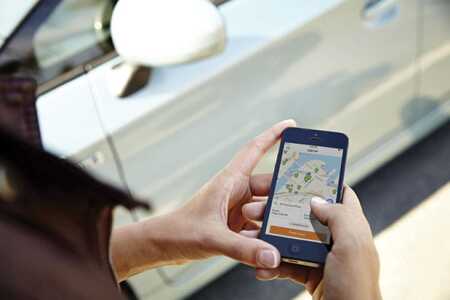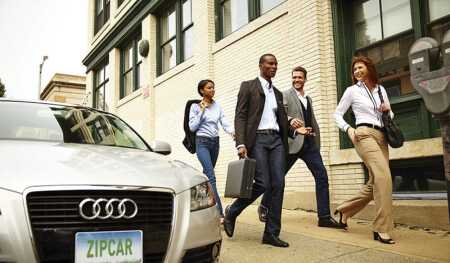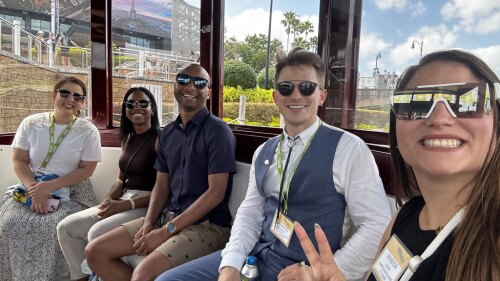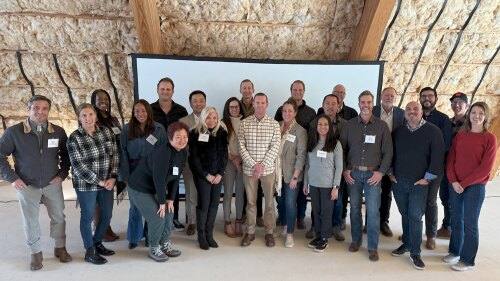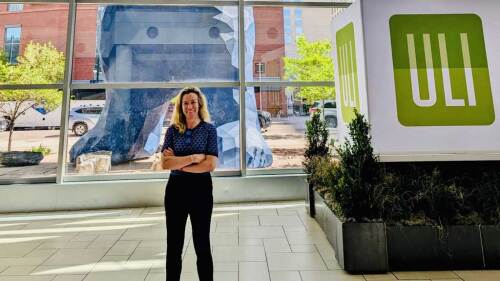Internationally acclaimed transportation entrepreneur Robin Chase, who rose to prominence in the early 2000s as cofounder and chief executive officer of Zipcar, the largest car-sharing company in the world, has been named the 2017 recipient of the ULI J.C. Nichols Prize for Visionaries in Urban Development. Chase is the 18th recipient of the prize, which recognizes a person, or a person representing an institution, whose work demonstrates a commitment to the creation of communities that reflect the highest standards of design and development.
The Nichols Prize honors the legacy of Kansas City, Missouri, developer J.C. Nichols, a founding ULI member considered to be one of America’s most creative entrepreneurs in land use during the first half of the 20th century. Nichols built his signature development, Country Club District, to accommodate what he correctly anticipated would be the future proliferation of automobile owners in urban areas.
Chase—the first Nichols Prize laureate whose career has not directly involved real estate practices or policy making—conceived Zipcar in 2000 as a car ownership alternative that would provide easy, convenient, and inexpensive access to vehicles on an as-needed basis.
With its debut, Zipcar disrupted car ownership dependence and the car rental process by allowing urban residents to reserve online, and securely pick up and drop off cars on an hourly basis from unattended parking locations around the city; years later, the process would be further simplified with a smartphone app.
“TODAY, WE HAVE DIFFERENT COMMUNITIES THAN WE COULD IMAGINE TEN YEARS AGO THAT ALLOWS US TO CONNECT WITH OTHERS WHO SHARE COMMON INTERESTS. WE HAVE TECHNOLOGY THAT ALLOWS US TO CONNECT WITH OTHERS WHO SHARE COMMON INTERESTS. WE ARE SEEING NEW FORMS OF COMMUNITY EMERGE FROM THE SHARING ECONOMY. WITH ZIPCAR, ROBIN PRODUCED SOMETHING WE ALL USE, BUT IT’S NOT SOMETHING WE KNEW WE NEEDED UNTIL IT WAS INTRODUCED TO US. HER PASSION IS ABOUT INNOVATION, STAYING AHEAD OF THE GAME, AND THINKING ABOUT THINGS THAT OTHERS ARE NOT. IN TODAY’S WORLD, WE ALL NEED THAT."—Mark W. Johnson
The effects and implications of Zipcar rippled quickly through city planning departments, the development industry, and academia, raising questions such as how much and what kind of parking is necessary to satisfy city residents? And, relieved of the expense of owning and maintaining an auto, some city dwellers could better afford their city’s housing prices.
Starting with one Volkswagen Beetle in Cambridge, Massachusetts, the company now offers more than 12,000 vehicles to over 1 million users in 500-plus cities around the globe.
The lasting impacts of Chase’s car-sharing idea on urban design and development are what earned her the Nichols Prize, which is the Institute’s highest honor. She demonstrated how sharing vehicles reduces the number of cars used by urban residents as well as the number of parking spaces they need. She also demonstrated that sharing is welcomed by the mainstream of people and that it has a viable business model. Zipcar set the stage for the rise of the sharing economy, including Airbnb, Uber, and Lyft.
“It’s important to acknowledge that the issues driving urbanization in America are about more than real estate,” says Nichols Prize jury chairman Mark W. Johnson, president of Civitas. “Technology is having a big impact on the formation of communities. Today, we have different communities than we could imagine ten years ago because we have technology that allows us to connect with others who share common interests. We are seeing new forms of community emerge from the sharing economy.
“With Zipcar, Robin produced something we all use, but it’s not something we knew we needed until it was introduced to us, Johnson says. “Her passion is about innovation, staying ahead of the game, and thinking about things that others are not. In today’s world, we all need that.”
In her 2015 book, Peers Inc, Chase explains the three premises on which Zipcar was based, and which have guided her pursuits since leaving the company in 2003:
- Leveraging/sharing excesscapacity (such as unused cars) makes economic sense;
- Online technology platforms make sharing simple; and
- Peer collaboration (such as Zipcar’s system of having users refuel the cars without assistance) ensures the system’s success.
“Enabled by new technology, a revolution is taking place inside capitalism as we reimagine the role of consumers, producers, and even ownership. I call this new paradigm Peers Inc: a transformation of the relationship between companies and people,” she writes. “Peers Inc finds abundance where there was once scarcity . . . Peers Inc is leading the transition from industrial capitalism to the collaborative economy.”
“CONSIDER BUILDING LOBBIES, WHICH ARE EMPTY MOST OF THETIME—THAT’S A PRIME EXAMPLE OF EXCESS CAPACITY. ANOTHEREXAMPLE IS APARTMENTS—WE NEED TO BE BUILDING MOREAPARTMENTS THAT CAN BE EXPANDED OR SHRUNK TO ACCOMMODATEHOUSEHOLDS OF DIFFERENT SIZES. OR PARKING—EVERYONE WHOIS INCLUDING PARKING IN THEIR DEVELOPMENTS SHOULD BEBUILDING IT SO IT CAN BE REUSED FOR SOMETHING ELSE. THERE ISREAL MONETARY VALUE IN MULTIPURPOSE SPACES.”—Robin Chase
After leaving Zipcar, Chase served as the founder of and former chief executive officer for Buzzcar, a peer-to-peer car-sharing company; and GoLoco, which enabled ride sharing. She was a cofounder and board member of Veniam, a vehicle communications company that moves massive amounts of data between vehicles and the cloud, allowing buses to act as mini cell towers and enabling the safe and reliable operation of self-driving cars. Her current work includes a focus on maximizing the potential of autonomous cars to improve the quality of life in urban areas. Recently, Chase shared some insights on the connection between urban mobility and the built environment with Urban Land.
Q: How would you describe the connection between mobility and the built environment?
Most people don’t think about transportation until they can’t get where they want to go from where they are. Mobility is the center of our lives. Our entire well-being, our access to opportunity and to what we can achieve in life are based on whether can we get to places easily, affordably, and safely. Mobility and development should go hand in hand. Livable cities are those that plan for and think through the details of the relationship between the two.
Q: Has a tipping point been reached in terms of building cities for people rather than for cars?
Some terrible stuff is still being built, but I do think we are seeing momentum in the right direction, with cities being designed to put people first. Zipcar’s primary markets are places where people don’t need a car to get to work—such as cities—as well as university towns. When I founded Zipcar, I had to spend a lot of time explaining that a lot of people want a car only sometimes, not all the time. People were doing the math and didn’t like paying $200 a month for parking a car they used only once a month. Today, people get it [Zipcar] immediately. They understand you can live carless in a city by choice. The focus has shifted from movement of cars to movement of people—and that is a significant economic attractor. That is what makes cities competitive.
Q: Is the Zipcar model—facilitating sharing to leverage excess capacity—the future of how people will experience cities?
If we think about parts of cities we really enjoy, such as benches outside coffee shops, and streets that are converted into farmers markets or festivals, we are enjoying spaces that are being multipurposed. It’s interesting to think about this in terms of private as well as public space, such as how the design of a building can allow for more than one use. Consider building lobbies, which are empty most of the time—that’s a prime example of excess capacity. Another example is apartments—we need to be building more apartments that can be expanded or shrunk to accommodate households of different sizes. Or parking—everyone who is including parking in their developments should be building it so it can be reused for something else. There is real monetary value in multipurpose spaces. Zipcar made it possible to “buy” a car for just an hour. In the future, I can imagine rethinking the “minimum purchase size” for retail space and curb space. Instead of paying for parking by the hour, we should be charging by the minute, or five-minute increments, for pickup and drop-off and delivery. Instead of renting a storefront by the year, imagine what it would be like to do so by the day or week. We are seeing this in the hotel and office markets. Retail and parking are ripe for such changes as well.
Q: The amount of space devoted to parking and its location are being reconsidered given the advancements in autonomous vehicle technology. What are your thoughts on this?
The first autonomous cars are going to be very expensive, and they will not be cars that you can drive anytime, anyplace, anywhere. They will be “geo-fenced” to travel within certain areas of cities, as well as to and from the airport. The time lag between the availability of these geography-restricted cars to “anywhere, anytime” cars is likely to be ten to 15 years. Those first cars are going to be shared and active 60 percent of the time, not sitting idle 95 percent of the time like personal cars. And when they do need to be parked or recharged, you’re not going to choose expensive downtown real estate; you’ll send them to cheaper locations. There is absolutely no need for more parking to be built in cities because we are moving toward a place in time where, because of sharing, we will need only a fraction of the cars we have now, and we won’t need nearly as much space for parking as we have now. I see this as a boon for both city dwellers and developers.
Q: How is technology changing how we use personal space other than cars?
Technology has allowed us to get over the fear of sharing our things with strangers. It enables us to find what we want, to access it, pay for it, evaluate it, and rate it—and be rated and evaluated ourselves—all discreetly and simply. Technology is how the people who reserve Zipcars can unlock them without having to deal with a key exchange. There is a parallel to this [access] that is applicable to housing. I’m intrigued by the potential of a cheap, easy way to access, for example, certain rooms for certain times—a way to use more of theunused space in people’s homes and public buildings. When someone says, “I can’t let my downstairs space be used by strangers, or a community dance class to use our gym because they might trash it,” I say, “You can let people use it because you will know who last unlocked the door.”
Q: In Peers Inc, you maintain that the sharing economy helps make cities more sustainable and equitable. How does it do this?
There are three benefits of leveraging excess capacity and sharing. First, it is cost-efficient, which is good from a business perspective. Second, it is resource-efficient, which is important from an environmental perspective. And lastly, it creates more opportunities for more people to participate [in society]. Take solar roofs: when I install solar panels on my roof, and I have excess capacity flowing into the grid, I am helping pay for a bit of the energy grid infrastructure. This can also be applied to wireless technology. We are moving toward more mesh networks that will equip more of the devices we use to transmit wireless signals, so that we are contributing to wireless infrastructure, not just using it. Applying this to physical spaces opens up possibilities for more people to benefit from sharing, as both consumers and producers of these new hyper-local experiences. On a small scale, think about community storage spaces where athletic equipment, tools, and other items could be stored and checked out using a bar code, so that everyone does not need to have their own drill or their own skates. We could be heading in the direction with spaces that allow more stuff to be shared inexpensively and simply.
All of this comes down to flexibility—being flexible in our thinking about what we use and how we use it, whether it’s stuff or space. Being flexible with space—building in multipurposing—allows uniquenesses to emerge that distinguish places from each other. That should be a goal for developers, to ensure that they are leaving evolvable space for the people in a community, now and in the future, to localize and make it their own.
Q: What other advice would you offer ULI members to stay at the forefront of city building?
How you build is shaping the quality of life for hundreds of thousands—even millions—of people. Be thoughtful about the relationship to the street, and the multipurposing of space, because those are the things that profoundly affect people’s lives. When developments are poorly designed, they make people miserable every day. It is a moral and humanitarian imperative that real estate professionals think long and hard about that as they design and build our cities. I’d like to see every new building be climate friendly and repurposable. If each new building or each renovated building could contribute to a sustainable, livable future, I think we as a society do have a chance to change our future prospect of climate hell. Or, more positively: we are in a position to reshape today’s cities so that they work much better than they did in the past. ULI’s members are part of what it takes to improve people’s lives.
Chase will be speaking at the ULI Fall Meeting in Los Angeles on a session titled, Real Estate + Technology: What Opportunities Will Emerging Technology Present for the Real Estate Industry? How to Register
Trisha Riggs is senior vice president of communications at ULI.


